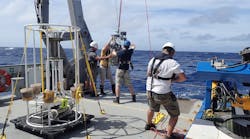What can we learn from the various microbial populations that span our oceans? Protozoa, archaea, and bacteria are very sensitive to their surroundings, changing various aspects of their metabolism to survive with the nutrients available to them. The organic materials used in these metabolic cycles, along with their byproducts, directly affect the levels of organic materials such as nitrogen, hydrogen, oxygen, and carbon in the water, sediments, and atmosphere. Furthermore, changes in microbial metabolism may offer a different perspective on the health of our oceans and the effects of temperature, current, and water composition.
To this end, Woods Hole Oceanographic Institution (WHOI) is studying the biochemistry of microbes in low-oxygen maritime regions—also known as dead zones— where aerobic lifeforms that depend on free oxygen in the water cannot survive. The scientists plan to collect various population samples of microbes to analyze a large database of anaerobic mechanisms throughout Atlantic Deadzones. They hope to gain insight on current cycles of organic materials in dead zones and their effects on the Earth’s atmosphere.
During its 22-day “ProteOMZ” exhibition, WHOI scientists traveled through dead-zone regions between Hawaii and Tahiti aboard the Schmidt Ocean Institute’s R/V Falkor research vessel. They used a rosette to collect thousands of microbial-population samples by pumping seawater through collecting filters as they traveled the ocean. The method allowed them to accumulate microbial samples at various depths up to 1000 meters, and subsequently examine the effects of water pressure, underwater currents, and temperature on oxygen levels and microbial metabolism.
The next step is to use a range of new techniques at WHOI’s Saito laboratory to map out the enzymes and functions in different anabolic and catabolic mechanisms. Using an established targeted metaproteomics (a type of protein analysis) approach, the team will analyze the structure and functions of several enzymes that catalyze metabolic reactions. With such a wide sample size, thousands of mechanisms will be investigated above and beyond those we already know, such as Krebs and Calvin cycles. Since high-temperature waters tend to have low levels of dissolved oxygen, the study also expects to uncover the effects of global warming on our atmosphere and maritime biomes.
Finally, the study should also provide clues about hurricane effects on ocean waters, since the expedition occurred during a strong El Niño year.
